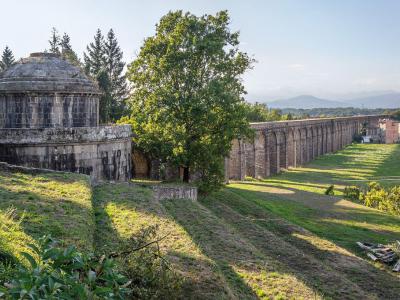
Aqueduct of Nottolini, Lucca
The Aqueduct of Nottolini is an aqueduct in Neoclassical Style near the city of Lucca. The 19th-century structure brought water to Lucca from the mountains south of the city through a stone channel supported by more than 400 arches, stretching for over 3 kilometres. It is now interrupted by the east-west autostrada A11 from Florence to Pisa.
While the arches of the aqueduct are often confused as being those of an ancient Roman aqueduct, construction of the aqueduct was begun in 1823 by the architect Lorenzo Nottolini, under the rule of Maria Luisa of Spain, Duchess of Lucca, and continued until 1851. In the slopes of Monte di Vorno, a number of springs were conveyed through rocky channels to a domed circular stone temple-cistern.
The water was then conveyed northward through covered stone conduits to the temple-tank of San Concordio, just outside the fortified walls of Lucca. The arches were mainly built with brick.
From the San Concordio tank, potable water was led by metal pipes into fountains in the city, starting with the circular fountain in Piazza Antelminelli next to Lucca Cathedral.
When inaugurated, the flow of water was governed completely by gravity. The final iron conduits allowed for expansion and contraction of the metal. The interruption of the aqueduct occurred when the autostrada was constructed by Benito Mussolini's government in 1928–1932.
While the arches of the aqueduct are often confused as being those of an ancient Roman aqueduct, construction of the aqueduct was begun in 1823 by the architect Lorenzo Nottolini, under the rule of Maria Luisa of Spain, Duchess of Lucca, and continued until 1851. In the slopes of Monte di Vorno, a number of springs were conveyed through rocky channels to a domed circular stone temple-cistern.
The water was then conveyed northward through covered stone conduits to the temple-tank of San Concordio, just outside the fortified walls of Lucca. The arches were mainly built with brick.
From the San Concordio tank, potable water was led by metal pipes into fountains in the city, starting with the circular fountain in Piazza Antelminelli next to Lucca Cathedral.
When inaugurated, the flow of water was governed completely by gravity. The final iron conduits allowed for expansion and contraction of the metal. The interruption of the aqueduct occurred when the autostrada was constructed by Benito Mussolini's government in 1928–1932.
Sight description based on Wikipedia.
Want to visit this sight? Check out these Self-Guided Walking Tours in Lucca. Alternatively, you can download the mobile app "GPSmyCity: Walks in 1K+ Cities" from Apple App Store or Google Play Store. The app turns your mobile device to a personal tour guide and it works offline, so no data plan is needed when traveling abroad.
Aqueduct of Nottolini on Map
Sight Name: Aqueduct of Nottolini
Sight Location: Lucca, Italy (See walking tours in Lucca)
Sight Type: Attraction/Landmark
Sight Location: Lucca, Italy (See walking tours in Lucca)
Sight Type: Attraction/Landmark
Walking Tours in Lucca, Italy
Create Your Own Walk in Lucca
Creating your own self-guided walk in Lucca is easy and fun. Choose the city attractions that you want to see and a walk route map will be created just for you. You can even set your hotel as the start point of the walk.
Lucca's City Wall and Gates
As one of Italy's Città d'arte's (arts towns), Lucca is famous, among other things, for its well-preserved ancient walls encircling the historic center. From about 570 AD until 1847 the city had been the center of the Longobard administration and the capital of old Tuscany, and as such required a defense system to render it an impenetrable fortress.
Back in the Middle Ages, the... view more
Tour Duration: 2 Hour(s)
Travel Distance: 3.7 Km or 2.3 Miles
Back in the Middle Ages, the... view more
Tour Duration: 2 Hour(s)
Travel Distance: 3.7 Km or 2.3 Miles
Lucca Introduction Walking Tour
Lucca is called many things: a city of arts, a city of churches, gardens, towers. Most of all it is known for its walls. From Roman times until now the walls have stood. It is the only city in Italy that has kept its walls intact.
The inner walled city is laid out in the ancient Roman grid plan. The Piazza San Michele is the site of the old forum. Bits of the Roman amphitheater can be found in... view more
Tour Duration: 2 Hour(s)
Travel Distance: 2.9 Km or 1.8 Miles
The inner walled city is laid out in the ancient Roman grid plan. The Piazza San Michele is the site of the old forum. Bits of the Roman amphitheater can be found in... view more
Tour Duration: 2 Hour(s)
Travel Distance: 2.9 Km or 1.8 Miles
Puccini's Lucca
One of the greatest musical talents of mankind, Italian composer Giacomo Puccini, was born and spent a substantial part of his life in the Tuscan city of Lucca. Today the legacy of Puccini resonates all over the world and even more so here.
Puccini's ancestors, also musicians, moved to Lucca in 1719. The future maestro was born in a house that had belonged to his family since 1815 – Casa... view more
Tour Duration: 1 Hour(s)
Travel Distance: 1.5 Km or 0.9 Miles
Puccini's ancestors, also musicians, moved to Lucca in 1719. The future maestro was born in a house that had belonged to his family since 1815 – Casa... view more
Tour Duration: 1 Hour(s)
Travel Distance: 1.5 Km or 0.9 Miles



